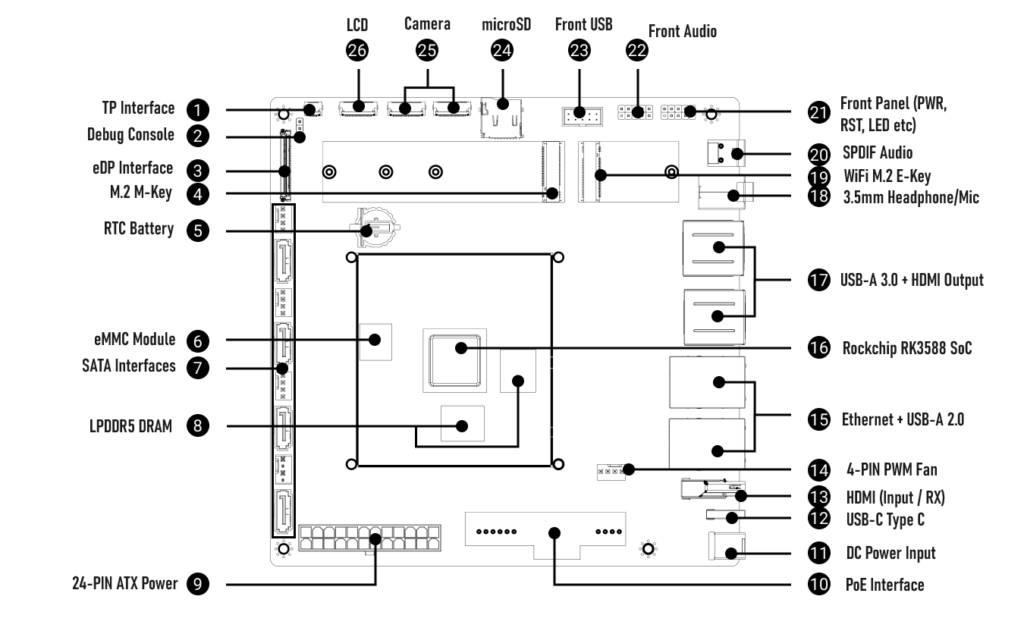With nothing else quite yet ready for the “big time”, the Rockchip RK3588 at the heart of the Radxa ROCK 5 ITX continues to be the top dog in the ARM SBC market, and with extensive work going on to provide full upstream support for the chip and its various boards, we should soon be able to unleash its full potential without the need for creative vendor kernels.
What exactly is unleashing its full potential though? Arguably, the Octa-core RK3588 SoC is powerful enough to perform quite a number of tasks that a “traditional” desktop computer could process and with the available expansion, it’s certainly an option.

That’s exactly what Radxa are banking on with their ROCK 5 ITX board that will be making its way out to users later this year.
Table of Contents
ROCK 5 ITX Specifications: What We Know So Far
Those of you that have already seen or worked with an RK3588 board won’t be majorly surprised at the specifications as ultimately it’s the same SoC with the same I/O available to it so I’m not going to give you a big ol’ table. You can view that in my RK3588 vs Intel N100 review if you like.
Due to the Pico-ITX form-factor used on the ROCK 5B though, space was somewhat limited and some of the more common expansion ports were made available directly on the board.

What you’ll see here in terms of differences between the 5 ITX and 5B is that the ROCK 5 ITX uses LPDDR5 instead of the (up to 4224MHz) LPDDR4 DRAM found in the ROCK 5B. Radxa themselves mention that this offers around 10% better performance on the memory side but we’ll have to wait to see how it looks in benchmarking when they arrive in the reviewer’s hands!
Differences in I/O to the ROCK 5B
Most of the core expansion options remain in place, such as the HDMI (both in and out!), microSD, and M.2 for an NVMe SSD. Though on the ROCK 5 ITX, the M.2 NVMe connector only has 2 PCIe Gen 3 lanes routed to it, as opposed to the 4 you see on the ROCK 5B. The other 2 lanes go to the 4 SATA ports. 2 lanes isn’t terrible as it offers twice the throughput available on the Raspberry Pi 5, but this is a desktop device, so users may be looking for a bit more, especially if this is to be used in a NAS setup where a fast NVMe drive for caching could be crucial.
Notable I/O differences include:
- eDP Interface (Embedded Displayport)
- RTC Battery Slot
- 4x SATA Interfaces
- LPDDR5 DRAM (Soldered)
- PoE Add-On Board
- DC Power Input
- SPDIF Audio
As it’s an ITX board targeted at desktop use, we also see:
- Front Panel Connectors (Power, Reset, LED etc)
- Front Panel USB (USB2.0 only)
- Front Panel Audio
- 24-pin ATX Power
- 4-pin PWM Fan Header
- LGA115x Mounting for a heatsink/cooler
Do alternatives exist?
For many this will be the first Mini-ITX/ITX (same difference) ARM board that they’re seeing, especially with a recent chip such as the RK3588. It’s worth noting that we do already have one option from Firefly. The Firefly ITX-3588J is another ITX form-factor board with a Rockchip 3588 at its heart, though in this instance it utilises a System on Module (SoM) that connects to the carrier board rather than everything being contained on a single board.

An interesting inclusion on the Firefly offering is the PCIe slot that’s exposed with 4 Gen 3 lanes, though it does away with an M.2 NVMe slot in favour of an M.2 SATA interface (though it also has the same 4 SATA interfaces on the board) so there’s a tradeoff to be had there depending on your needs.
At a glance though, it seems that the Radxa ROCK 5 ITX is genuinely targeted at being used in a desktop case/setup, whereas the ITX-3588J from Firefly just uses the ITX form-factor as there’s a lack of front panel connectors or similar interfaces to really work in that way.
Conclusion
As of yet the pricing is unknown, though it’s really going to have to battle with Intel N100 based setups that, depending on features, go for between $100-200 USD and with those you know you’re not going to have any software headaches.
If they can get the pricing right, I can see this as an interesting prospect for those that really want to roll a small ARM powered desktop in a more “traditional” form factor, or have an ARM-powered NAS/home server with plenty of options.
There’s a good mix of I/O available, with no fewer than 4 storage interfaces on the board, and dual 2.5GbE RJ45 Ethernet means it’ll be no slouch on most home networks, allowing you to squeeze a bit more out of your network attached storage if that’s the route you choose to go down.
If TrueNAS Scale supported ARM hardware then I’d be tempted to use this as a home server setup but as it is, with the software still being a work in progress, I think I’ll stick to my little PN50 for a while longer.
Could you see yourself picking one of these up? If so, for what purpose? Let me know in the comments below!